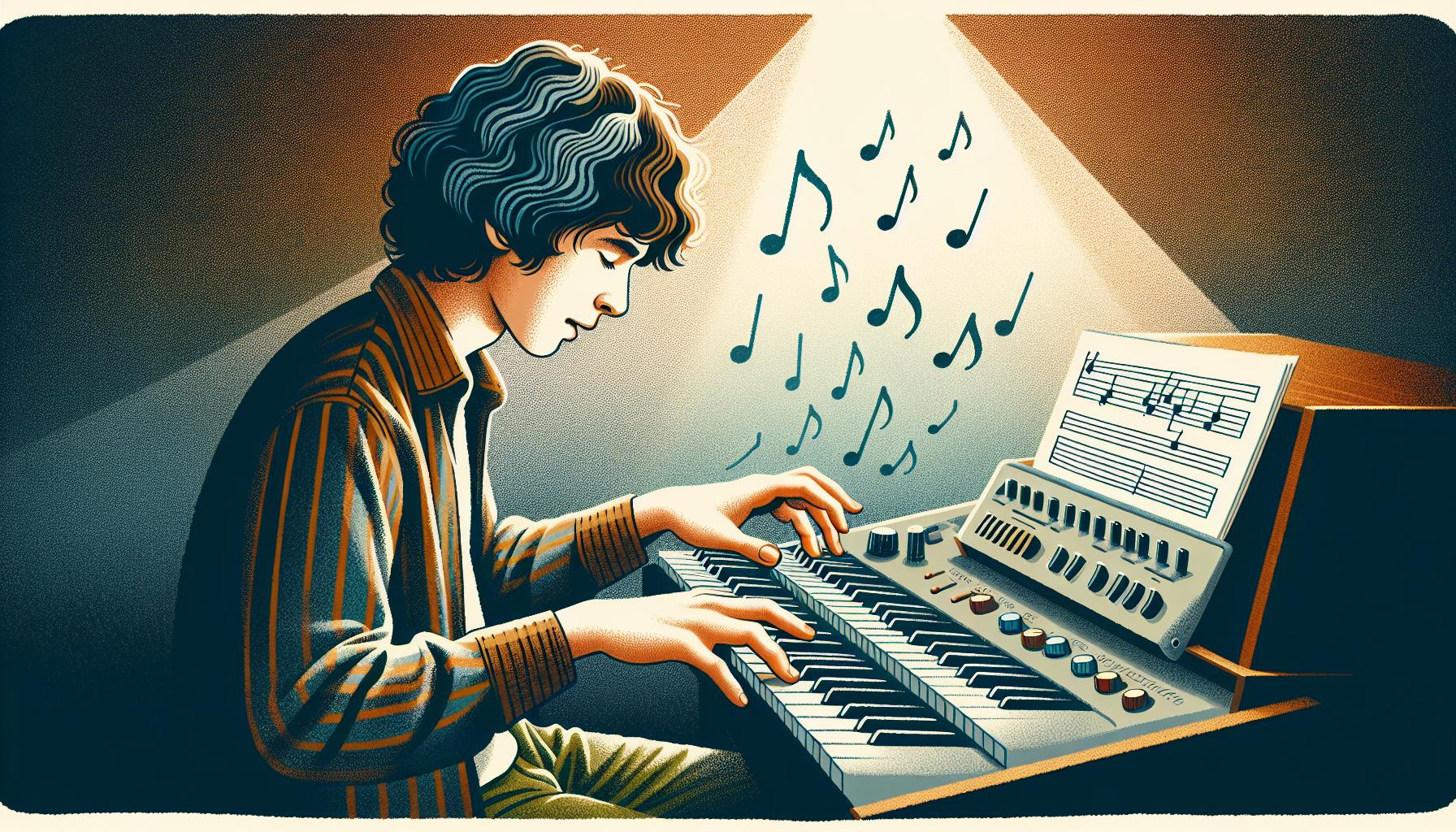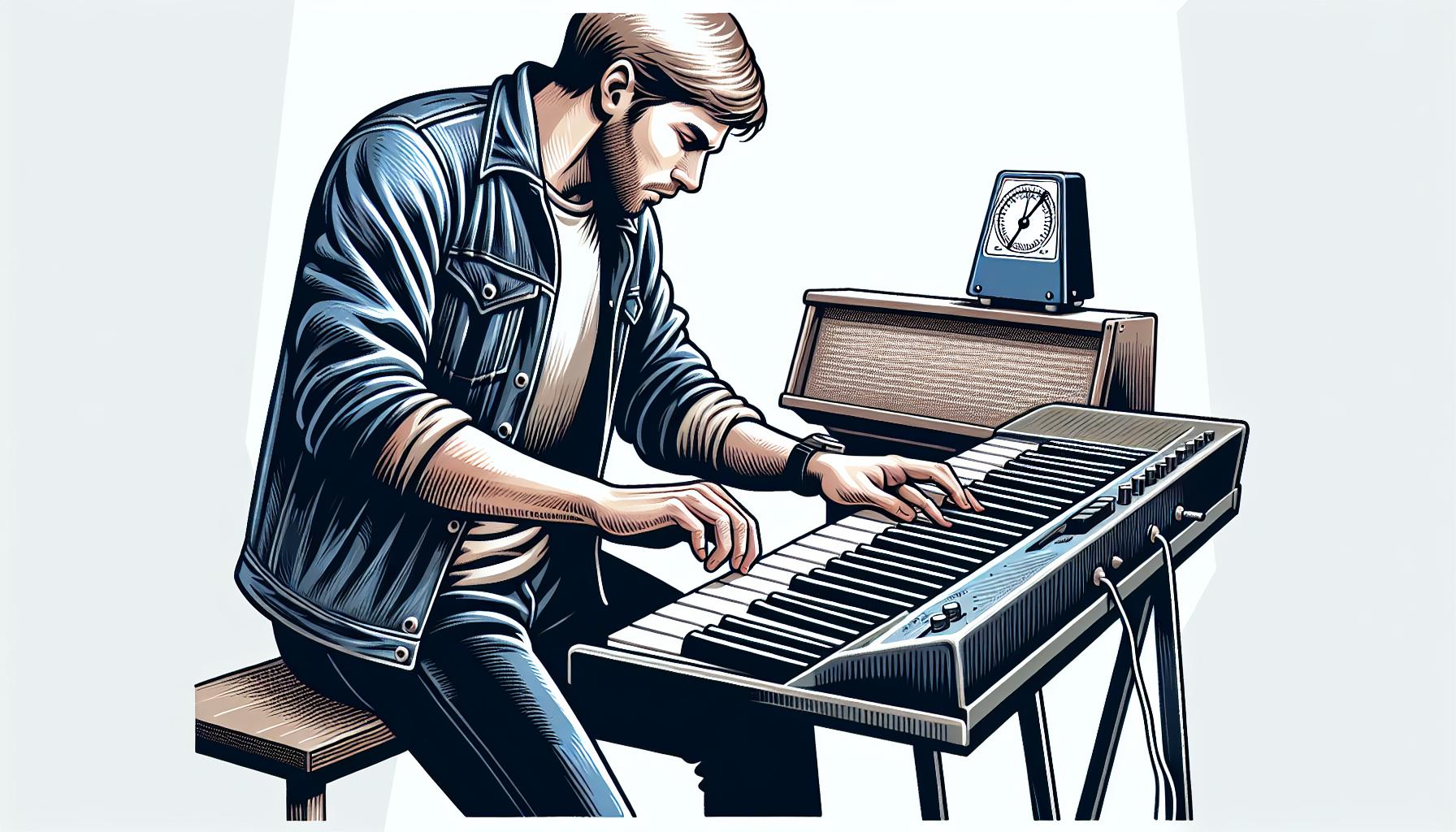Diving into the world of rock music as a beginner keyboardist can feel like an exhilarating leap. It's where the energy of rock blends with the melodic prowess of the keyboard, creating a playground for novices eager to make their mark. But where does one start in this vast sea of chords and melodies?
Thankfully, there are rock songs out there that are not just iconic but also beginner-friendly. These tracks are perfect for getting your fingers accustomed to the keys while rocking out. They strike the perfect balance between challenge and accessibility, ensuring you're not overwhelmed as you embark on your musical journey.
Understanding Rock Keyboard Basics
Venturing into the world of rock keyboard may seem daunting at first, but it's a journey packed with excitement and discovery. For beginners, grasping the fundamentals can transform an overwhelming process into an enjoyable learning experience. Rock keyboard often involves dynamic rhythms and distinctive sounds that set it apart from other music genres. Key components such as chord progressions, riffs, and the use of synthesizers are pivotal in creating the iconic rock sound.
Chord Progressions and Riffs
At the heart of rock music are chord progressions and riffs that give each song its unique character. Beginners should start by mastering simple chord shapes and patterns. This foundational knowledge enables new keyboardists to navigate through songs with greater ease. Practicing with familiar tracks can significantly boost confidence, as learners start recognizing the structures and patterns that recur across various rock songs.
Embracing Synthesizers
Synthesizers play a crucial role in enriching rock music's texture and depth. For beginners, familiarizing themselves with basic synthesizer settings can open up a world of sounds that closely align with rock's energetic vibes. Starting with preset sounds often found in keyboards or software can help learners get accustomed to the synthetic aspect of rock. Experimenting with different settings allows beginners to explore how varying sounds can impact a song's overall feel.
Essential Skills for Rock Keyboardists
Successful rock keyboardists don't just rely on technical abilities. Developing a strong sense of timing and rhythm is equally important. Many rock songs feature sections where the keyboard takes the lead, requiring precise timing to synchronize with the rest of the band. Practicing with a metronome or along with recordings can improve timing and help beginners feel the groove of rock music.
Another vital skill is learning to play by ear. While sheet music for rock songs is available, many rock musicians thrive on improvisation and adaptation. Being able to pick up tunes by ear and adapt them for the keyboard allows for more creativity and personal expression. It encourages beginners to experiment and find their unique style within the rock genre.
Essential Techniques for Beginners

When diving into rock keyboard songs as a beginner, there are several essential techniques that can significantly boost one's musical journey. Mastering these techniques not only enhances the ability to play more complex pieces but also adds depth and emotion to the performance.
Hand coordination is paramount. Rock music often demands the keyboardist to play different rhythms or even melodies simultaneously with both hands. This can seem daunting at first, but starting with simple exercises that focus on independent hand movements can greatly improve coordination over time.
Another crucial technique is understanding and implementing dynamics. Dynamics refer to the variations in loudness or softness in music and can dramatically change the feel of a song. Beginners should practice playing the same piece at different dynamic levels to explore how it affects the music's energy and emotion.
Proper posture and hand positioning also play significant roles in a beginner's development. Incorrect posture or positioning can not only hinder skill advancement but may also lead to strain or injury. Beginners should ensure they're sitting at the right height, keeping their backs straight, and positioning their fingers on the keys comfortably and effectively.
Incorporating scales and arpeggios into daily practice is crucial for improving finger dexterity and speed. While it might not seem directly related to playing rock songs, having a solid understanding of scales and arpeggios helps in navigating the keyboard more efficiently and adds a layer of sophistication to the music.
Lastly, experimenting with the synthesizer's various sounds and effects is both fun and educational. Many classic rock songs incorporate distinctive synthesizer sounds that contribute significantly to their overall impact. By familiarizing themselves with these sounds, beginners can add authenticity and flair to their performances.
While diving into these techniques, beginners should remember that progress takes time and patience. Regular practice, combined with a passion for rock music, will pave the way for a rewarding musical journey.
Top Rock Keyboard Songs for Novices

When beginners are looking to dive into the world of rock keyboard songs, the vast selection can seem overwhelming. It's crucial to pick tracks that not only resonate with one's musical tastes but are also within skill reach. Starting with simpler songs allows for a gradual build-up of both confidence and technical ability. Here's a curated list of iconic rock keyboard songs ideal for novices.
"Let It Be" by The Beatles
This classic is perfect for beginners due to its slow tempo and repetitive chord progressions. "Let It Be" not only introduces players to the concept of chord variations but also allows them to practice transitions smoothly.
"Clocks" by Coldplay
Featuring a distinctive piano riff, "Clocks" is a great piece for practicing rhythm and timing. The song’s repetitive patterns serve as an excellent exercise for hand coordination and endurance.
"Don't Stop Believin'" by Journey
A staple in the rock genre, "Don't Stop Believin'" provides beginners with the opportunity to work on sustaining notes and playing multiple chords. Its uplifting melody and straightforward progression are engaging for players of all levels.
"Bohemian Rhapsody" by Queen
While the full complexity of "Bohemian Rhapsody" may be daunting, certain segments are approachable for beginners. Focusing on the piano ballad portion allows novices to engage with dynamic changes and expressive playing.
Practice Tips
To master these songs, beginners should consider several practice tips:
- Start Slow: Begin by playing each song at a slower pace to ensure accuracy. Gradually increase the tempo as confidence builds.
- Use Metronome: Incorporating a metronome helps maintain consistent timing, a critical skill for any musician.
- Break It Down: Work on small sections of the song at a time. Mastering piece by piece is less overwhelming and more effective.
- Record Practice Sessions: Listening back to practice sessions can help identify areas for improvement.
Progress Tracking
Keeping track of progress is crucial. Here’s a simple framework:
| Week | Song | Skill Focus | Progress Notes |
|---|---|---|---|
| 1 | "Let It Be" by The Beatles | Chord Transitions | Improved fluency in transitions |
| 2 |
Breakdown of Iconic Rock Hits

When diving into the world of rock keyboard songs, a few tracks stand out for their unforgettable melodies and chord progressions. These hits not only define the genre but also serve as excellent learning material for beginners.
"Let It Be" by The Beatles
One of the most iconic songs in the rock repertoire, "Let It Be" features a simple yet profound piano line. It's an ideal starting point for beginners due to its slow tempo and repetitive chord structure. The song allows players to focus on basic chord formations and smooth transitions without the pressure of complex rhythms.
- Key skills developed:
- Chord transitions
- Sustaining notes
- Expressive playing
"Clocks" by Coldplay
A masterpiece of modern rock, "Clocks" by Coldplay is famed for its hypnotic piano riff. Playing this song, beginners get a taste of how rhythm and melody intertwine, creating a captivating musical experience. The repetitive nature of the riff makes it a great exercise for finger independence and timing.
- Key skills developed:
- Rhythm and timing
- Finger independence
- Playing repetitive patterns
"Don't Stop Believin'" by Journey
This anthem is a journey through dynamic chord progressions and engaging melodies. For beginners, "Don't Stop Believin'" is a chance to explore a more upbeat pace while still working within accessible chord changes. The song provides a balance of challenge and achievability, making it a rewarding experience for early-stage players.
- Key skills developed:
- Dynamic playing
- Upbeat tempo mastery
- Melodic and chordal balance
"Bohemian Rhapsody" by Queen
Engaging with "Bohemian Rhapsody" allows beginners to experience the theatrical and eclectic style of Queen. Though it may seem daunting, focusing on the ballad section of the song offers a manageable challenge that includes slower tempos and simpler chords. This piece is perfect for enhancing expressive playing and understanding complex song structures.
- Key skills developed:
- Expressive playing
- Understanding song structure
- Introduction to complex arrangements
Perfecting Your Performance

Mastering keyboard songs, especially rock anthems, goes beyond just hitting the right notes. It involves a blend of technique, expression, and sometimes, a bit of showmanship. For beginners eager to perfect their performance, there are several key areas to focus on.
Technique Is the Foundation
First and foremost, technique lays the groundwork for any successful performance. Beginners should prioritize:
- Finger positioning: Keeping fingers curved and relaxed prevents fatigue and increases agility.
- Posture: Proper posture ensures comfort and control during long practice sessions.
- Sight-reading: The ability to read music swiftly allows for smoother learning and performing experiences.
Incorporating these fundamentals can significantly enhance the quality of one’s playing, making even the simplest songs resonate with listeners.
Emotion and Expression
Music, at its core, is about conveying emotion. When playing iconic rock hits, injecting personal interpretation and emotion intensifies the connection with the audience. This includes:
- Dynamics: Varying the volume throughout the piece to reflect its emotional landscape.
- Tempo nuances: Slightly speeding up or slowing down to add excitement or anticipation.
- Expressive techniques: Using pedals for sustain or vibrato on key notes adds depth to the performance.
Practice Makes Perfect
Consistency in practice is vital. Regular, focused sessions will lead to noticeable improvements. Beginners might find it helpful to:
- Set realistic goals: Break down songs into manageable sections and focus on mastering one at a time.
- Use metronomes: They help in maintaining a steady tempo and improving rhythm.
- Record practices: Listening back can reveal areas for improvement not noticed in the moment.
Connect With the Song
Understanding the story or emotion behind a song can dramatically improve how it's played. Engaging with the lyrics or the origin of the piece offers insights into its heart, guiding the emotional delivery and dynamics of the performance.
Incorporate Multimedia Learning
Utilizing tutorials, play-along videos, and even game-based learning platforms can make practice sessions more engaging and effective. They offer:
- Visual guides for finger positioning and movement
- Varied interpretations of the same song for broader understanding
- Instant feedback in some game-based learning platforms
Conclusion
Mastering rock keyboard songs as a beginner might seem daunting at first. However, with the right approach, it's entirely achievable. Remember, it's not just about hitting the right notes. It's about bringing the music to life with your unique touch. By focusing on technique, emotion, and consistent practice, you'll not only improve your skills but also deepen your connection with the music. So, keep practicing, stay patient, and most importantly, enjoy the journey of musical discovery. There's a world of rock keyboard songs waiting for you to explore and make your own.
Harlan Kilstein began playing piano during covid with no piano background at all. He taught himself how to play learning what to do and what not to do.
Today he's an advanced intermediate player and can help you grow in your skills because he learned all this on his own.








